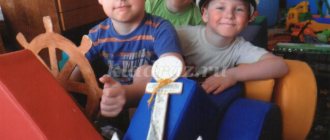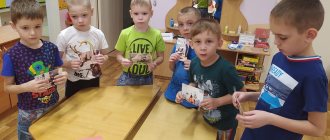Recommendations for parents
It is difficult for a small “producer” to come up with an interesting plot in the first stages. He has not yet sufficiently mastered the world in which adults live. During this period, it is necessary to help the baby, show how and what to play. The variety of plots, their duration and emotional intensity will depend on the parents’ imagination. When organizing entertainment for adults, you need to follow several rules:
- Don't force. If the child is not in the mood or he was simply planning to put together a picture from puzzles, there is no need to start building a spaceship. First you need to ask whether the baby wants to do this and only after receiving consent can he begin to take active action. At the first sign of loss of interest, it is better to stop the activity.
- Don't force yourself into rigid boundaries. Let the child show his imagination and contribute to the development of the plot.
- Create a friendly atmosphere. Leave aside the strict intonations, irritation and authoritarian manners; they are completely unnecessary here. Play on equal terms, or better yet take on secondary characters: a patient in a clinic, a disheveled model in a hairdresser; incompetent road user. Guide your child’s actions slowly, gradually, so that he doesn’t feel it.
Role-playing activities not only entertain, but are also an element of the educational process that allows you to understand the laws by which people live. In addition, they instill in the younger generation communication skills and help them become independent individuals, ready to overcome any adversity in life. More interesting information about toys and children's development can be read on our blog.
Story-based role-playing games in middle and senior groups
The table shows these 8 types of role-playing games, which are practiced in middle and senior groups.
| Role-playing game | Move |
- Shop
- Hospital
- Family
| Dolls, clothes for them, iron, ironing board, paper, meter, scissors for patterns. | Children build relationships with each other and become familiar with cutting and sewing. | The kids make a pattern, then cut it out and sew dresses for the dolls. |
(Traffic Laws)
A painted zebra, a traffic controller's stick, a traffic light. Training in correct behavior on the street and crossing the road, familiarization with traffic lights. Dividing children into traffic controllers, drivers and pedestrians. The teacher explains the rules, and the children play in situations he has invented. 7. Cafe Tray, tea set, fruit, special uniforms, toy menus, and pyrogens. Know how to serve and respect each other. The cook, waiter and visitors feel it. Everyone does their job. Their goal is to provide quality service to the visitor. 8. School Bell, blackboard, glasses, notebooks, books, pens, backpack. Introduce children to the school and learn that this is a specific place of study. They overcome their fear of school. The teacher rings the bell and invites the students to enter the classroom as they begin the lesson. Children call, sit quietly, do not play around, and answer questions by raising their hand.Levels of role-playing play: from 3 to 7 years
The main indicator of the development of the game is its sequence: the beginning of the process, the culmination and the logical conclusion. Observing children during activities helps adults notice behavioral deviations at an early age and make efforts to eliminate them. Child psychologists find a relationship between the child’s age, his level of development and the complexity of play activities:
- 3-4 years. Mostly kids play with adults, whose help at this stage is quite significant. Parents come up with a plot, hold an imaginary situation, guide the children and provide guidance. Children often try to play on their own, but such activities are usually short-term and limited to a couple of actions: wash the dishes, put the doll to bed, feed the teddy bear. The plot does not unfold further - no one eats, no one praises them for clean plates, and no one wakes up. At this stage, the game should teach children to act according to the script, develop imagination and enrich their vocabulary.
- 4-5 years. From this age, children begin to master simple plot directions in which they try on various images: a mother, a sister, or a doctor from a children's clinic. They actively interact with toys, talking for themselves and for them. At this age, children can already join groups (2-3 people) for joint activities. The company helps 4-5 year old players develop communication skills, teaches how to conduct a dialogue, independently distribute responsibilities and select toys.
- 5-6 years. The main focus of the game is the relationships between people, whose roles the children distribute among themselves. Toys are selected to match the invented scenario. The everyday theme is complemented by work activities and significant events in life. Must be consistent with the character and actions of the assigned role. While playing, the child develops the ability to determine the rules and change the plot, activates dialogical speech, enriches his social experience (learns the rules of behavior on the road, in transport, cafes, shops, etc.)
- 6-7 years. At this stage, children act meaningfully, aware of their relationships with partners. While playing out scenes, they jealously monitor their friends’ compliance with generally accepted rules: “Dads don’t act like that,” “Dinner doesn’t start with the second course,” “Girls don’t behave like that”—such phrases are often heard in the company of older preschool-age children. Creative role-playing games with exciting plots, content, new characters, and a fairy-tale world come to the fore. The children themselves prepare the scenery and attributes, select toys, and add elements of dance and singing to the scenes.
Play is the leading activity of a preschooler and occupies an important place in his life. Children are transported from everyday routine to an imaginary situation, try on interesting roles, use images and imagination to act in the play space. At this time, adults receive in their hands a powerful tool for influencing the child’s future inclinations, his actions and character. You can read about the benefits of wooden toys in the article “Wooden educational toys: features and benefits for children.”


